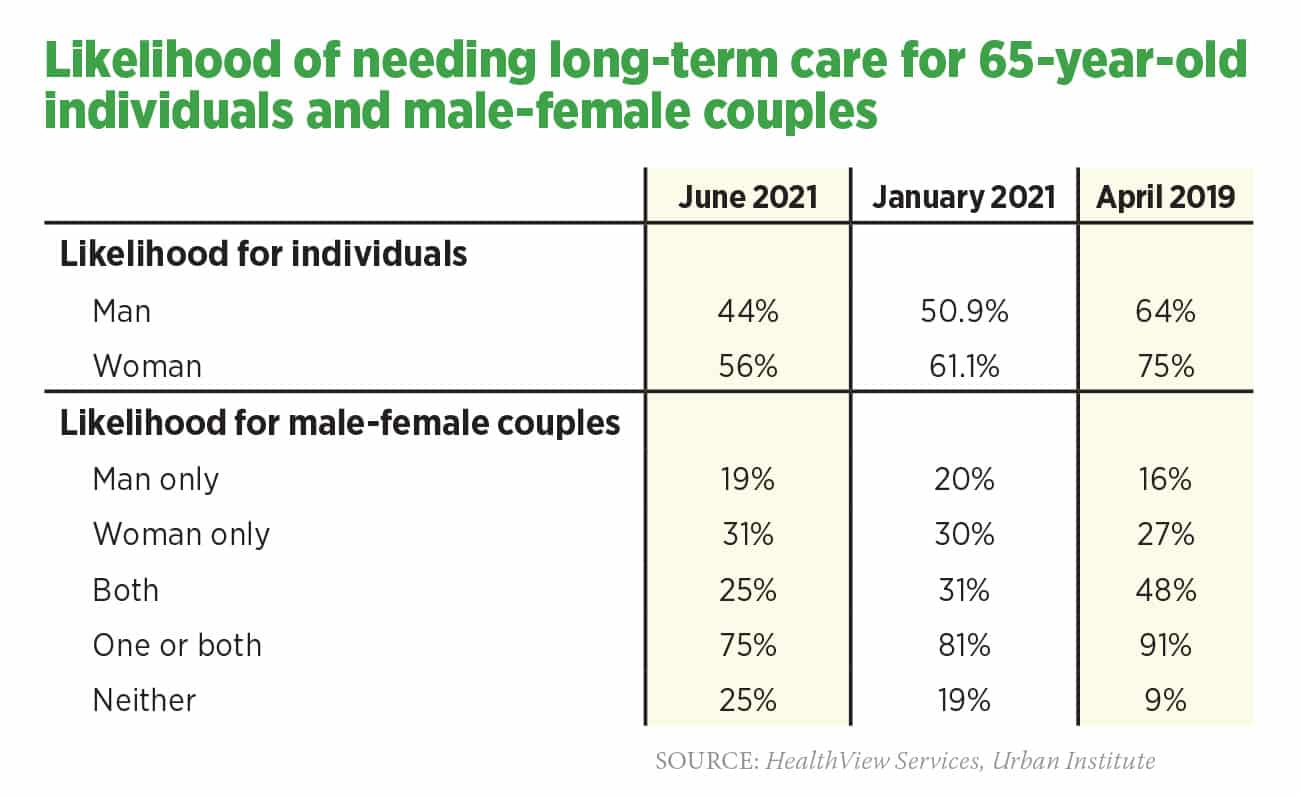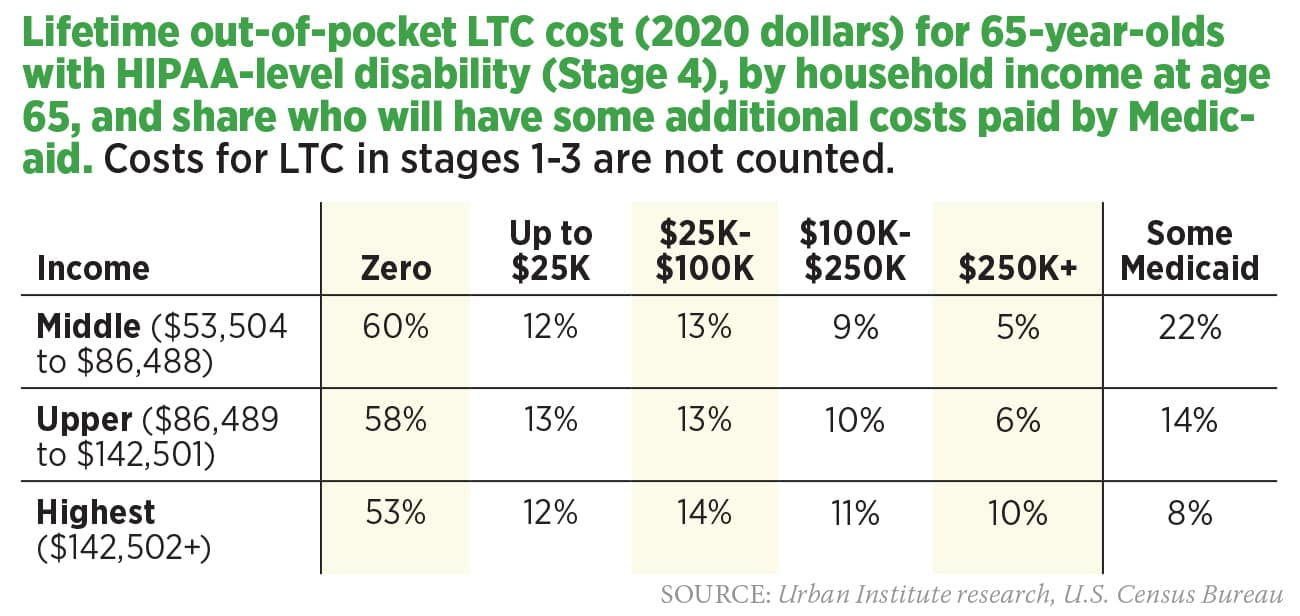[ad_1]
We often hear conflicting statistics about the likelihood that clients will need long-term care, the type of care they are likely to need and, most importantly, the cost of that care. But there are a number of variables that go into estimates of the cost of LTC and the likelihood that a client will need care. Here are some of the factors that go into these estimates.
The likelihood and cost of LTC depends on the definition of LTC. There are two ways to estimate the likelihood and cost of LTC, and several factors determine these estimates.
Method 1: Strict HIPAA definition.
Estimates of the likelihood and cost of LTC are generally based on criteria established by the Health Insurance Portability and Accountability Act of 1996. A person needs LTC if a licensed health care professional certifies that they need help. for at least two of the activities of daily living for 90 days or more or need supervision due to severe cognitive impairment. Medicaid and some financial services companies use this definition to determine eligibility for LTC benefits.
This approach underestimates the true likelihood and cost of LTC because people who need care at pre-HIPAA disability levels are not counted.
Method 2: When care is needed for the first time and costs are incurred.
This approach estimates the likelihood and cost of LTC from the perspective of care recipients and caregivers. The steps identified here were created for the purpose of this discussion only.
Advertising
»Stage 1 (AIVQ care). Help is needed and expenses may be incurred due to difficulty in performing instrumental activities of daily living including cooking, housework, laundry, managing finances and medical care, using the telephone and computer, shopping and transportation.
»Stage 2 (care pending). Medical conditions worsen or cognitive abilities decrease. Paid caregivers may be needed. Step 2 is when many people indicate their first need for SLD, regardless of the HIPAA criteria. (See step 4.)
»Step 3 (practical care). More care is needed and more expense is incurred. Paid caregivers are often needed. Step 3 still does not meet HIPAA criteria. (See step 4.)
»Step 4 (HIPAA level care). A healthcare provider certifies that LTC is necessary according to the HIPAA definition.
Research published by the Urban Institute shows that one in four (26%) who pays for care and almost three in four (71%) who only receive unpaid care are not included in most LTC statistics because their disability does not meet HIPAA criteria.

What is the likelihood that LTC will be needed?
Table 1 presents recent estimates of the likelihood of LTC for individuals and couples. In 75% to 91% of couples, one or both (joint probability) will need LTC.
These projections underestimate the likelihood that care will be needed because the projections do not include people who live beyond their lifespan or who never reach HIPAA level of disability.
June 2021. Likelihood that healthy 65-year-olds will need some level of LTC by the time they reach actuarial life expectancy for men (86) and women (87).
»January 2021. Probability of needing LTC from age 65 until death. These are future (prospective) probabilities based on the HIPAA definition of SLD.
»April 2019. Probability of needing LTC from age 65 until death. This is historical (retrospective) data based on the self-reported need for HIPAA level SLD.

Cost of LTC Based on HIPAA Level Disability (Step 4)
Table 2 shows the January 2021 government-sponsored estimate of the cost of LTC. These projections underestimate the out-of-pocket expenses because expenses incurred before reaching the HIPAA level of disability (stage 4) are not included.
Some people in each income group (based on income at age 65) become eligible for Medicaid when they need long-term care. The reasons include decades of general inflation, as well as wage and cost inflation for LTC services; reduced value of Social Security benefits because health insurance premiums (which are deducted from Social Security checks) often increase faster than increases in the cost of living; more taxes paid on social security benefits (the share of social security benefits included in taxable income increases because the thresholds for inclusion of benefits in taxable income are currently not indexed to inflation); and increased longevity (some people with relatively high incomes at age 65 are eligible for Medicaid when they reach the mid-1990s because they spend less money).
Let’s break down the different income groups and their care costs. Why do some groups have higher reimbursable fees than others?
»Average income ($ 53,504 to $ 86,488)
60% should have zero reimbursable expenses. Some people without charge never need treatment (the charge is really zero); some incur significant expenses for care in stages 1 to 3, but these costs are not counted (only the expenses of HIPAA level are included in the study); and some become eligible for Medicaid before spending their own money. 9% incur costs of $ 100,000 to $ 249,999 and 5% spend $ 250,000 or more. 22% have LTC expenses paid for by Medicaid.
»Higher income ($ 86,489 to $ 142,501)
58% should have zero reimbursable expenses. Some people at no cost never need care, others need care but never reach HIPAA severity level, and some become Medicaid eligible before spending their own money. 10% incur costs of $ 100,000 to $ 249,999, and 6% spend $ 250,000 or more. 14% have LTC expenses paid for by Medicaid.
»Highest income ($ 142,502 +)
53% should have zero reimbursable expenses. Some people at no cost never need care, others need care but never reach HIPAA severity level, and some become Medicaid eligible before spending their own money. 11% incur costs of $ 100,000 to $ 249,999 and 10% spend $ 250,000 or more. 8% have a portion of their LTC expenses paid for by Medicaid.
[ad_2]

